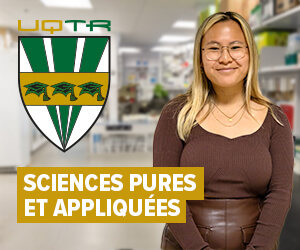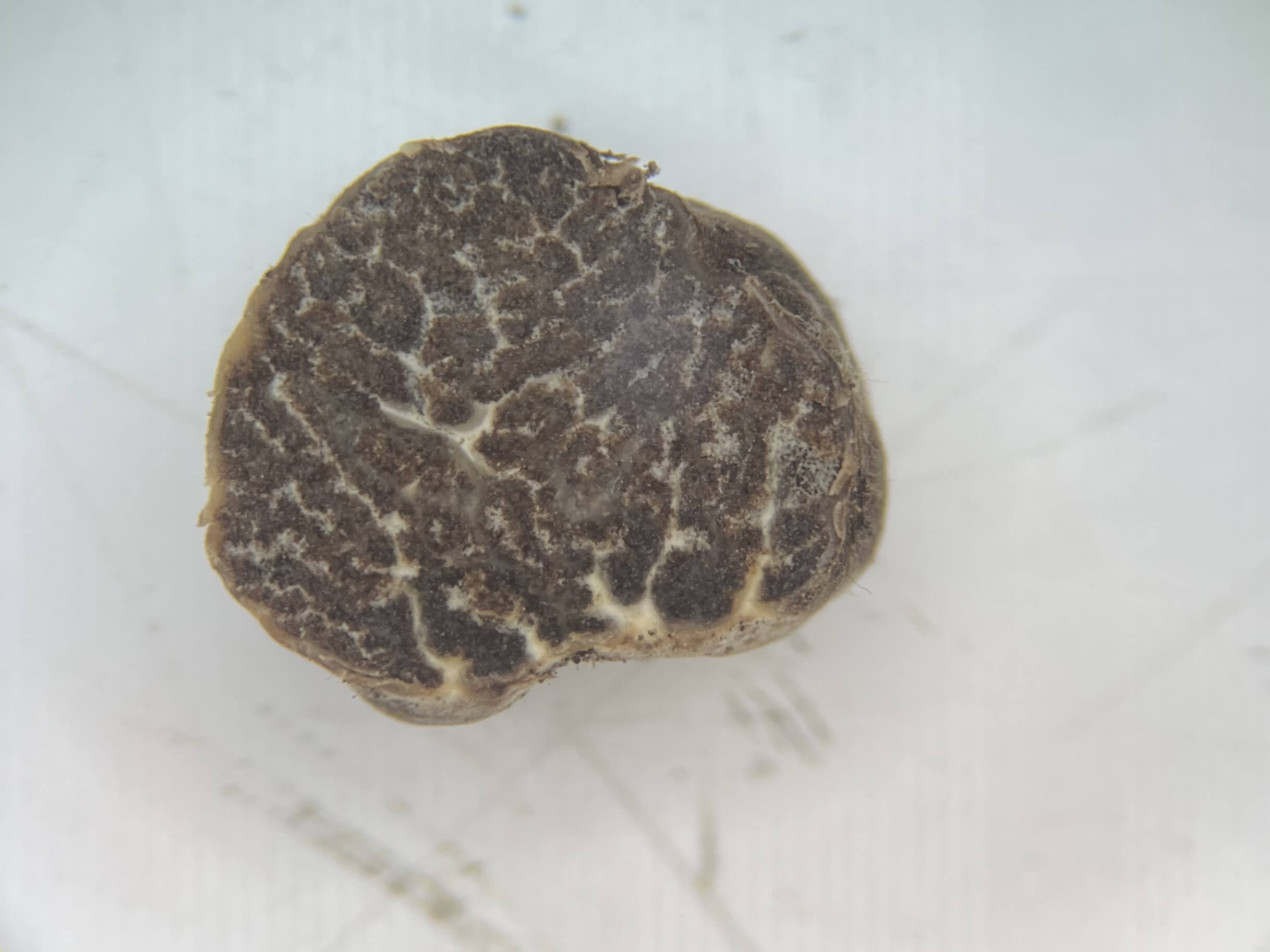Last October, during a course in the Environmental Sciences Department, UQTR students went on a trip to the campus woodland areas to pick mushrooms in the company of their teacher. During this activity, two participants were surprised to find a rather rare mushroom that grows underground known as truffle.
“These students were taking a course on fungal biology that I offered in the fall semester. As part of this training, two excursions are planned on campus. The first allows you to look for epigeous mushrooms that grow above the ground. The second is dedicated to the collection of hypogeic, i.e. underground, mushrooms. It was during this second activity that the truffle was discovered,” reports lecturer Théo Devèze, who is also a PhD student in Cell and Molecular Biology at UQTR.

Florence Gagné and Édouard Campbell, undergraduate students in biological and ecological sciences at UQTR, found truffles while mushroom picking on campus.
Among the twenty students who took part in the underground mushroom collection were Florence Gagné and Édouard Campbell, both enrolled in the bachelor’s degree in biology and ecology, who collected truffles.
“To find underground mushrooms, students must first find holes dug in the ground by small mammals such as rodents or squirrels. These animals search the ground to feed on these fungi. Using trowels or garden claws, students then carefully scrape around the holes to reveal hypogean fungi, which are usually found in the first few centimeters of soil,” explains Théo Devèze.
When Florence and Édouard discovered some specimens of underground mushrooms about one centimeter in diameter, they had no idea what species they were. It wasn’t until they got to the lab, where they had to identify their mushrooms based on various criteria, that they realized they were truffles.
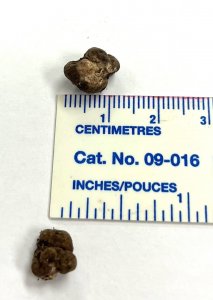
Two truffles harvested on the UQTR campus (Photo: Florence Gagné)
“The truffle has characteristic features that make it easy to identify,” emphasizes Théo Devèze. The interior of this mushroom is solid and covered with white veins that are visible when dissecting a sample. »
A still unknown species
But what type of truffle did the two students find? Is it an edible and delicious truffle that delights gourmets, or another variant of this mushroom?
“To determine the exact species, DNA analysis must be carried out. For this purpose, we provided a sample of the truffle to Professor Hugo Germain from UQTR’s Department of Chemistry, Biochemistry and Physics. His team performed various manipulations in the laboratory to extract DNA from the fungus. The DNA was then sent to the organization Génome Québec for the final phase of analysis, namely sequencing,” explains Théo Devèze.
Less than two weeks after the truffle harvest on campus, the lecturer and his students were informed of the results achieved by Génome Québec.
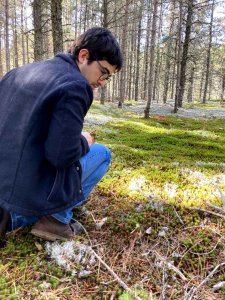
Lecturer and doctoral student in cell and molecular biology Théo Devèze on an autumn mushroom observation trip in a forest in the Saint-Alexis-des-Monts region. (Photo: Claire Letanneur)
“At first glance, the mushroom the students collected is not a known species. It is similar to a species of truffle called Tuber separans that grows in North America, but is not 100% identical. To ensure that this is indeed a new species of truffle, further research or possibly more in-depth DNA studies are required,” mentions Théo Devèze.
It is currently not possible to say whether this unknown truffle can be consumed. “Some truffles are said to be edible, but that’s because people have already tried them and survived the experience. In fact, there is no other way to determine the edibility of a mushroom than to taste it, with all the dangers that entails. If you have a mushroom that you have never eaten before, you should not eat it. Even through a chemical analysis of the mushroom, it can still be difficult to say whether it is edible, since the results obtained can reveal the presence of unknown, potentially toxic molecules,” emphasizes the doctoral student.
Another discovery from 2019
According to lecturer and biologist Véronique Cloutier, who developed the course on the biology of fungi at UQTR and taught it for several semesters, this is not the first time a truffle has been found on campus.
“In 2019, students discovered a specimen of Tuber rufum, an edible truffle with great variability in appearance and flavors, on the UQTR site. Remarkably, the specimen found was a purple truffle of great beauty,” says Véronique Cloutier. The latter, whose doctoral thesis was on the subterranean mushrooms of Quebec and the animals that consume them, took part in mushroom picking on campus with Théo Devèze’s student group.
Truffle: a fascinating mushroom
The special thing about truffles is that they live in symbiosis with the trees around them. “Thanks to a network of very fine filaments called mycelium, this fungus explores the soil and recovers nutrients. The mycelium can also fuse with the roots of a tree and form mycorrhiza, which allows the truffle to provide nutrients and water to that tree. In return, the latter distributes the sugar produced during photosynthesis to the truffle. The truffle discovered on campus this fall was harvested near white pines and large-leaved beeches,” describes Théo Devèze.

Truffle farmer in training, the sow Praline took part in the mushroom hunt on the UQTR campus. (Photo: Florence Gagne)
There are over a hundred species of truffles, but only a few are edible. In Europe, truffles are known and particularly sought after because of their taste and monetary value. In Quebec, truffles are becoming more common and projects are being developed to grow the Appalachian truffle, prized by gourmets.
To find out where truffles are hidden in the ground, you can use dogs that have learned to recognize the characteristic scent of these mushrooms. “Pigs are also trained for this type of prospecting,” explains Théo Devèze. A truffle pig in training also accompanied us on campus while collecting mushrooms. »
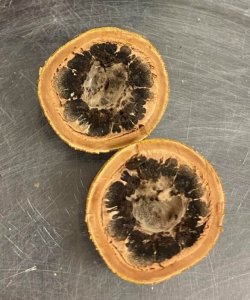
Cross section of the hypofermental fungus Elaphomyces muricatus (Photo: Audrey Fagundes)
Due to the autumn drought, the harvest of underground mushrooms on the UQTR campus was not very varied this year. “In addition to the truffle, the students only found one other hypogean mushroom species. This is Elaphomyces muricatus, a relatively common and inedible spherical mushroom with a yellowish appearance, found in various ecosystems and continents. The specimens collected by the students varied in size and were a few centimeters in diameter,” explains Théo Devèze.
During his university studies in plant biology, the lecturer was particularly interested in the interactions between plants and fungi. “Then I developed a passion for her. That’s why I teach a course on the biology of fungi. These still little-known organisms are biologically closer to animals than to plants,” adds Théo Devèze, who is currently working on his doctoral thesis on cannabis biodiversity.
